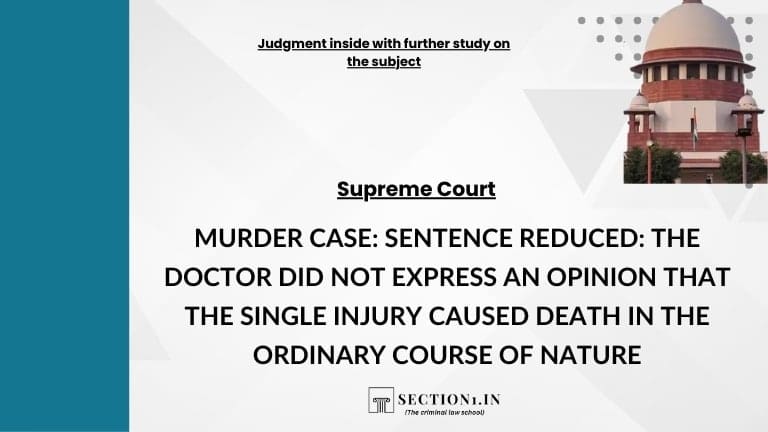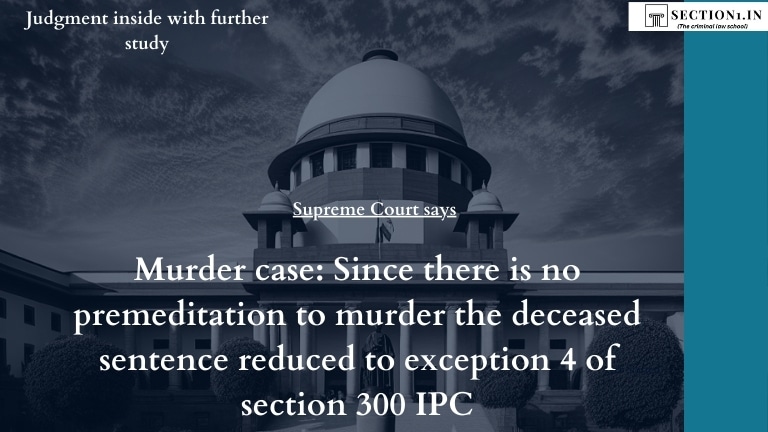10. At the outset, it requires to be noticed that while issuing notice of this appeal on 21.11.2016, it was restricted for the purpose of conversion of the offence. Hence, within this limited sphere this appeal has to be examined, namely, as to whether 9 judgement, order and sentence passed by the Sessions Court and affirmed by the High Court requires to be affirmed or the sentence is to be converted and punishment to be awarded under Section 304 of IPC and if so, which part of Section 304 IPC?
xxx
POST-MORTEM REPORT
13. Having given our anxious consideration as regards the genesis of the incident and the role attributed to the appellant herein and testimony of the doctors who treated her and also who performed the post-mortem of the deceased, discloses that doctor has noted two injuries on the deceased: (i) cut injury in the left ear measuring 3 centimetres and; (ii) Two wounds in left head roughly measuring 7 centimetres and near to that another small injury. The injuries, as noted in Post-Mortem Report Ex.P-9 are as under:
“(i) Sutured wounds: – On the lobule of right ear 2 cm in length. On removal of the sutures, edges are irregular, 0.5 cm in breadth and muscle deep, on the left temporal region of the scalp, 7 cm in length. On removal of the sutures, edges are irregular, 2 cm in breadth and bone deep, on the left parietal region of the scalp, 2 cm in length. On removal of the sutures, edges are irregular, 1 cm in breadth and bone deep. (ii) Resolving bruising of left temporal, left parietal and left side of occipital regions of scalp. Sub-dural haemorrhage and Sub arachnoid haemorrhage on both cerebral and cerebellar hemispheres. Fracture base of skull-left middle cranial fossa present.”
14. The cause of death assigned in the post-mortem report as already noticed is “died of head injury”. It is a trite law that “culpable homicide” is a genus and “murder” is its species and all “murders” are “culpable homicides, but all “culpable homicides” are not “murders” as held by this court in Rampal Singh Vs. State of Uttar Pradesh (2012) 8 SCC 289. The intention of the accused must be judged not in the light of actual circumstances, but in the light of what is supposed to be the circumstances.
15. In the case of Basdev Vs. State of Pepsu AIR 1956 SC 488 at page 490 the following observations have been made:
“Of course, we have to distinguish between motive, intention and knowledge. Motive is something which prompts a man to form an intention and knowledge is an awareness of the consequences of the act. In many cases intention and knowledge merge into each other and mean the same thing more or less and intention can be presumed from knowledge. The demarcating line between knowledge and intention is no doubt thin but it is not difficult to perceive that they connote different things. Even in some English decisions, the three ideas are used interchangeably and this has led to a certain amount of confusion.”
INTENT & KNOWLEDGE DISTINGUISHED
16. It requires to be borne in mind that the test suggested in the aforesaid decision and the fact that the legislature has used two different terminologies, ‘intent’ and ‘knowledge’ and separate punishments are provided for an act committed with an intent to cause bodily injury which is likely to cause death and for an act committed with a knowledge that his act is likely to cause death without intent to cause such bodily injury as is likely to cause death, it would be unsafe to treat ‘intent’ and ‘knowledge’ in equal terms. They are not different things. Knowledge would be one of the circumstances to be taken into consideration while determining or inferring the requisite intent. Where the evidence would not disclose that there was any intention to cause death of the deceased but it was clear that the accused had knowledge that his acts were likely to cause death, the accused can be held guilty under second part of Section 304 IPC. It is in this background that the expression used in Indian Penal Code namely “intention” and “knowledge” has to be seen as there being a thin line of distinction between these two expressions. The act to constitute murder, if in given facts and circumstances, would disclose that the ingredients of Section 300 are not satisfied and such act is one of extreme recklessness, it would not attract the said Section. In order to bring a case within Part 3 of Section 300 IPC, it must be proved that there was an intention to inflict that particular bodily injury 15 which in the ordinary course of nature was sufficient to cause death. In other words, that the injury found to be present was the injury that was intended to be inflicted. This Court in the case of Pulicherla Nagaraju @ Nagaraja Reddy vs State of Andhra Pradesh, AIR 2006 SC 3010 has observed:
“Therefore, the court should proceed to decide the pivotal question of intention, with care and caution, as that will decide whether the case falls under Section 302 or 304 Part I or 304 Part II. Many petty or insignificant matters – plucking of a fruit, straying of cattle, quarrel of children, utterance of a rude word or even an objectionable glance, may lead to altercations and group clashes culminating in deaths. Usual motives like revenge, greed, jealousy or suspicion may be totally absent in such cases. There may be no intention. There may be no premeditation. In fact, there may not even be criminality. At the other end of the spectrum, there may be cases of murder where the accused attempts to avoid the penalty for murder by attempting to put forth a case that there was no intention to cause death. It is for the courts to ensure that the cases of murder punishable under Section 302, are not converted into offences punishable under Section 304 Part I/II, or cases of culpable homicide not amounting to murder, are treated as murder punishable under Section 302. The intention to cause death can be gathered generally from a combination of a few or several of the following, among other, circumstances: (i) nature of the weapon used; (ii) whether the weapon was carried by the accused or was picked up from the spot; (iii) whether the blow is aimed at a vital part of the body; (iv) the amount of force employed in causing injury; (v) whether the act was in the course of sudden quarrel or sudden fight or free for all fight; (vi) whether the incident occurs by chance or whether there was any premeditation; (vii) whether there was any prior enmity or whether the deceased was a stranger; (viii) whether there was any grave and sudden provocation, and if so, the cause for such provocation; (ix) whether it was in the heat of passion; (x) whether the person inflicting the injury has taken undue advantage or has acted in a cruel and unusual manner; (xi) whether the accused dealt a single blow or several blows. The above list of circumstances is, of course, not exhaustive and there may be several other special circumstances with reference to individual cases which may throw light on the question of intention. Be that as it may”.
FACTS AND CONCLUSION
20. Thus, it emerges from the case law analysed herein-above for converting the sentence imposed under Section 302 to Section 304 Part II the facts unravelled during trial will have to be seen. In the facts of the case on hand, it is discernible that there was no premeditation to cause death or the genesis of occurrence and the single assault by the accused and duration of entire episode, were factors to adjudge the intention. The offence can be brought clearly within the ambit of Section 304 Part-II IPC. In the instant case it can be noticed that appellant and the deceased were in love with each other. The fact that deceased had stopped talking to the appellant and 26 she was talking to her neighbour Mr. Sudhakar had ignited the mind of the appellant to be furious about the conduct of the deceased and he was upset about this change of attitude of the deceased. Even according to the testimony of PW-1, who is none other than mother of the deceased there was altercation between the appellant and the deceased and exchange of words between appellant and deceased with regard to their love affair. On being confronted by the appellant as to why the accused had stopped talking to him and as to why she was trying to develop friendship with Sudhakar and the answer given by the deceased had resulted in appellant’s getting infuriated and in that spur of the moment he caught hold of her hair and banged her head to the wall which resulted in blood oozing out and on seeing this he ran away from the scene of the incident. Thus, the single assault by the appellant coupled with the duration of the entire period having occurred for about 2-3 minutes would not be sufficient to infer that he had the intention to kill the deceased. Had there been any intention to do away with the life of the deceased, obviously the appellant would have come prepared and would have assaulted the deceased with pre-meditation. Yet another factor which cannot go unnoticed, the appellant had obviously approached the deceased and intended to confront her as to why she was not talking to him though they were in love and also to clear the doubts about she being friendly with Mr. Sudhakar (neighbour) and in this factual scenario, heated exchange of words have taken place and enraged by her reply the appellant has banged her head on the wall in a fit of fury, which cannot be inferred that he had any intention to take away her life, particularly when he was in love with her.
21. In the aforesaid analysis of law and facts, we are of the considered view that the present appeal deserves to be allowed in part. The conviction of the appellant under 302 is altered/converted to one under Section 304 part II of the Indian Penal Code for the altered conviction, the appellant is sentenced to the imprisonment to the period already undergone and shall be released forthwith if not required in any other case.
PARTY: N. RAMKUMAR vs. THE STATE REP. BY INSPECTOR OF POLICE – September 06, 2023 – CRIMINAL APPEAL NO.2006 OF 2023.
https://main.sci.gov.in/supremecourt/2016/10094/10094_2016_13_1503_46779_Judgement_06-Sep-2023.pdf






